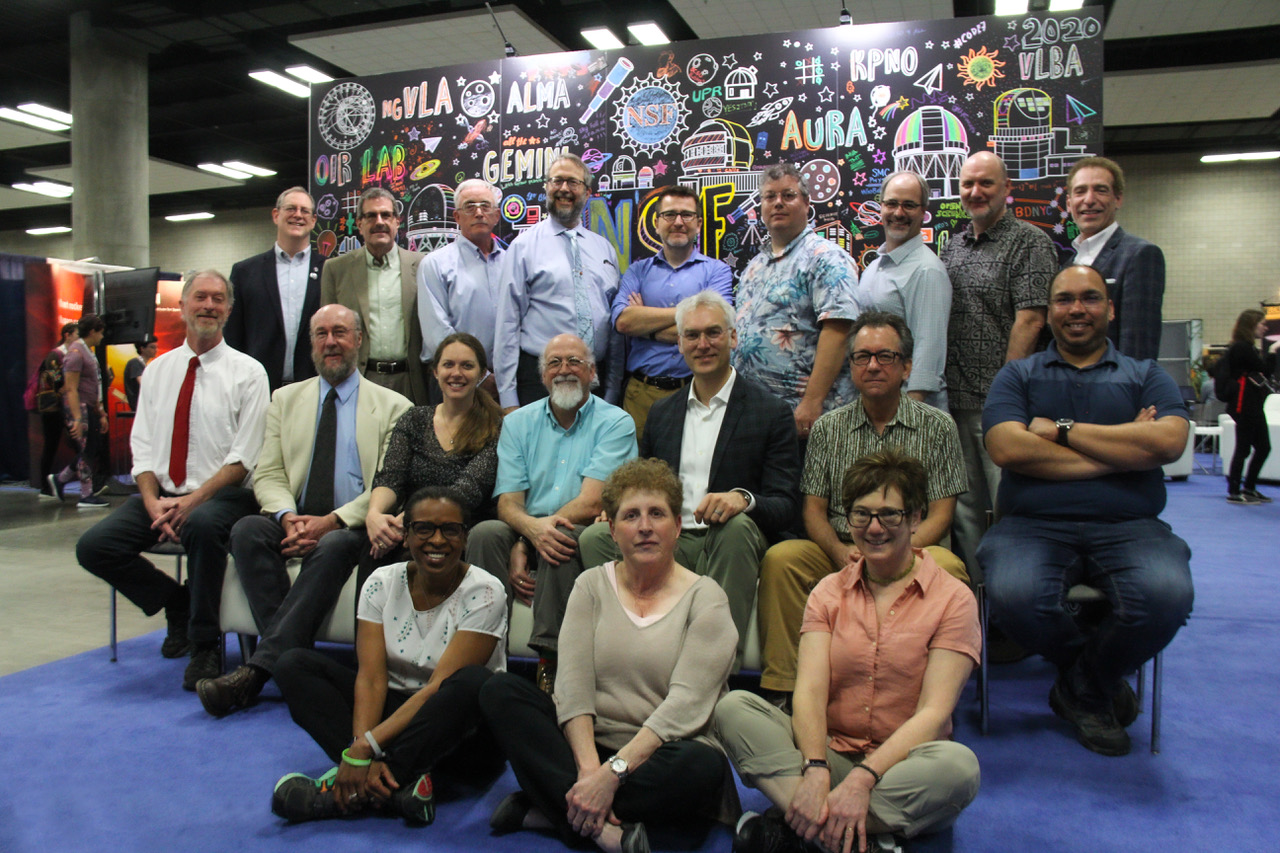About The Division of Astronomical Sciences (AST)
NSF Astronomy Staff at the January 2020 AAS Meeting 235
Pictured from left to right:
Top row: Chris Smith, Ralph Gaume (departed NSF in May 2021), Jim Neff, Hans Krimm, Martin Still, Luke Sollitt, Jonathan Williams, Chris Davis, Ed Ajhar.
Middle row: Glen Langston, Nigel Sharp, Ashley VanderLey, Matt Benacquista, Peter Kurczynski (departed NSF in July 2020), Rich Barvainis (departed NSF in December 2020), Harshal Gupta.
Front row: Donna O'Malley, Liz Pentecost, Ivy Kupec (OLPA - departed NSF).
Not pictured from AST: Tanner Abraham, Renee Adonteng, Andreas Berlind, Carrie Black, Dave Boboltz, John Chapin, Allison Farrow, Debra Fischer, Jim Higdon, Sarah Higdon, Craig McClure, David Morris, Zoran Ninkov, Alison Peck, Joe Pesce, Andrea Prestwich, Luca Rizzi, Matt Viau.
Mission
The Astronomical Sciences Division supports:
- Forefront research in ground-based astronomy; to help ensure the scientific excellence of the U.S. astronomical community;
- Provides access to world-class Research Facilities through merit review;
- Supports development of New Instrumentation and next-generation facilities; and
- Encourages broad understanding of the astronomical sciences by a Diverse Population of scientists, policy makers, educators, and the public at large.
The Division supports research in all areas of astronomy and astrophysics as well as related multidisciplinary studies. Because of the scale of modern astronomical research, the Division engages in numerous interagency and international collaborations. Areas of emphasis and the priorities of specific programs are guided by community recommendations, which have been developed and transmitted by National Research Council decadal surveys and by federal advisory committees.
The Astronomy Division is always seeking community guidance through NSF's merit review process. Please serve as a reviewer!
Staff
The AST staff serve the community through facilities management and Astronomical research awards to investigators.
Forefront Research
The Astronomy division participates in 65 solicitations supporting many different aspects of astronomical research, education, outreach and spectrum management.
The major research awards program is the Astronomy and Astrophysics Grants solicitation.
An important part of the Astronomy Division's effort is supporting technology development and instrumentation. Several different soliciations request proposals for different research projects.
These include:
- Advanced Technologies and Instrumentation (ATI)
- Major Research Instrumentation Program (MRI)
- Mid-scale Research Infrastructure (MSRI)
World Class Facilities
The NSF astronomy facilites are located in many states in the US, plus on most continents, including the South Pole.
The NSF operates some of the finest reserach facilities in the world. Along with many other facilites, some of the Astronomy facilities are highlighted in a recent Report and Press Releases.
Diverse Communities and Ideas
The NSF Astonomy division seeks participation from all segments of the population.
NSF Astronomy Division has several funding opportunities to help broaden participation.
Programs include:
- Partnerships in Astronomy & Astrophysics Research and Education (PAARE)
- Education and Special Programs (ESP)
- Research Experiences for Undergraduates (REU)
- NSF Astronomy and Astrophysics Postdoctoral Fellowships (AAPF)
- Alliances for Graduate Education and the Professoriate (AGEP)
Serve as a Proposal Reviewer
Reviewing proposals is a great way to learn the Astronomy Community's research priorities. Reviewing proposals also aids investigators in learning how compelling proposals are written.
The review process is summarized in online documents and a video dramitization of the review gives good overview of the NSF process.
Please register your proposal review preferences in this survey.



